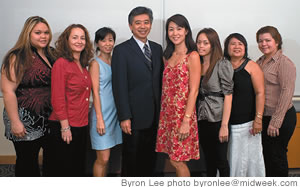
Seeing And Looking Better
February 27, 2008
By Dr. Hugo Higa


Dr. Hugo Higa
Ophthalmologist and Founder of the Aesthetic Vision Center
Interviewed by Melissa Moniz
First of all, tell us about yourself?
I was born and raised in Los Angeles, and attended medical school and completed an ophthalmology residency in Wisconsin. I then moved to Melbourne, Australia, where I completed two fellowships: one in corneal surgery and the other in oculoplastic surgery. I moved to Honolulu soon after.
How long has Aesthetic Vision Center been open?
I’ve been practicing in Honolulu since 1998 and started Aesthetic Vision Center in 2004.
{embed=“elements/box_ad”}
You are an ophthalmologist, as well as an oculoplastic surgeon. What is oculoplastic surgery?
Oculoplastic surgery is a sub-specialty of ophthalmology. It involves the medical and surgical treatment of eyelid and orbit disease. The most common orbital procedures involve the treatment of thyroid eye disease. The most common oculoplastic procedures include the correction of droopy upper eyelids and the correction of inward or outward turning eyelids. Browlifts are also performed.
What is the most common procedure performed at Aesthetic Vision Center?
By far, medically indicated cataract and eyelid surgeries are the most common. I also perform cosmetic eyelid and facial procedures. Aesthetic procedures involve lifting droopy upper eyelids and removal of excess skin and fat from both upper and lower eyelids. In addition I perform Fraxel laser treatments which may remove age spots and reduce wrinkles, as well as Botox cosmetic and Restylane injections to treat the aging face.

|
What medical conditions do you treat in your practice?
Like most ophthalmologists, my practice sees patients of all ages. In children and young adults, much of my time is spent on preventative eye exams and performing refractions for eyeglasses. In the older population, I treat diseases or conditions associated with aging, such as cataracts, glaucoma, and drooping lids. Other commonly seen conditions affecting the eyes include dry eyes, inflammation of the eyelids, and eye infections.
Do most patients come in knowing what they want, or do they often look to you to guide them in treatment and surgery options?
Both. For example, people who come for cataract evaluations may have only a minimal disturbance in their vision. Another person with a similar visual acuity may have reading or driving difficulties. Therefore it is very important to determine treatment based on what is bothering the person. This consideration also applies to droopy eyelids. People who have difficulty seeing peripherally or keeping their eyes open may wish to consider surgery to lift their eyelids before their daily activities become significantly impaired.
Potential cosmetic surgery patients who come in for consultation often have a specific idea of how they would like their appearance to be following surgery. It is important for me to make them feel comfortable about their decision to pursue aesthetic surgery. My treatment philosophy has always been to perform as little surgery as possible to achieve the best results.
{embed=“elements/google_ad336x280”}
What is the average length of the surgeries and recovery times for the procedures you perform?
Cataract surgery takes about ten to fifteen minutes to perform. Vision recovery following surgery is usually quick, with many patients seeing well at the first post-operative visit. Upper eyelid surgery takes about an hour to perform. Bruising is expected for about ten days to two weeks. Residual swelling may persist for a little longer after that.
What part of your job do you find most challenging?
I think it is exciting to start and grow a medical practice. Challenges are great opportunities. One challenge that I am keenly aware of is ensuring that we continue to provide quality care to each patient in a practice that keeps growing, both in the number of patients and in staff. Another challenge is to make sure that I am providing patients with the latest successful medical and cosmetic procedures. Overall, I really enjoy what I do and look forward to each new workday.